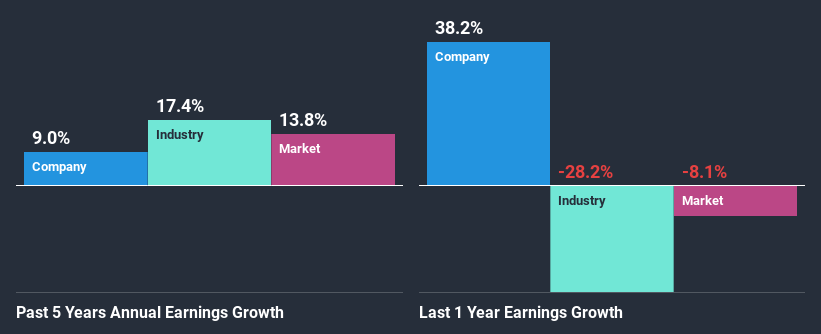- India
- /
- Metals and Mining
- /
- NSEI:TINPLATE
The Tinplate Company of India Limited's (NSE:TINPLATE) Stock Is Going Strong: Have Financials A Role To Play?

Most readers would already be aware that Tinplate Company of India's (NSE:TINPLATE) stock increased significantly by 36% over the past three months. As most would know, fundamentals are what usually guide market price movements over the long-term, so we decided to look at the company's key financial indicators today to determine if they have any role to play in the recent price movement. In this article, we decided to focus on Tinplate Company of India's ROE.
Return on equity or ROE is an important factor to be considered by a shareholder because it tells them how effectively their capital is being reinvested. In short, ROE shows the profit each dollar generates with respect to its shareholder investments.
Check out our latest analysis for Tinplate Company of India
How To Calculate Return On Equity?
The formula for return on equity is:
Return on Equity = Net Profit (from continuing operations) ÷ Shareholders' Equity
So, based on the above formula, the ROE for Tinplate Company of India is:
10% = ₹793m ÷ ₹7.6b (Based on the trailing twelve months to June 2020).
The 'return' is the amount earned after tax over the last twelve months. One way to conceptualize this is that for each ₹1 of shareholders' capital it has, the company made ₹0.10 in profit.
What Has ROE Got To Do With Earnings Growth?
Thus far, we have learned that ROE measures how efficiently a company is generating its profits. We now need to evaluate how much profit the company reinvests or "retains" for future growth which then gives us an idea about the growth potential of the company. Generally speaking, other things being equal, firms with a high return on equity and profit retention, have a higher growth rate than firms that don’t share these attributes.
A Side By Side comparison of Tinplate Company of India's Earnings Growth And 10% ROE
At first glance, Tinplate Company of India's ROE doesn't look very promising. However, the fact that the company's ROE is higher than the average industry ROE of 7.4%, is definitely interesting. This probably goes some way in explaining Tinplate Company of India's moderate 9.0% growth over the past five years amongst other factors. That being said, the company does have a slightly low ROE to begin with, just that it is higher than the industry average. Hence there might be some other aspects that are causing earnings to grow. Such as- high earnings retention or the company belonging to a high growth industry.
Next, on comparing with the industry net income growth, we found that Tinplate Company of India's reported growth was lower than the industry growth of 17% in the same period, which is not something we like to see.

The basis for attaching value to a company is, to a great extent, tied to its earnings growth. It’s important for an investor to know whether the market has priced in the company's expected earnings growth (or decline). By doing so, they will have an idea if the stock is headed into clear blue waters or if swampy waters await. Is Tinplate Company of India fairly valued compared to other companies? These 3 valuation measures might help you decide.
Is Tinplate Company of India Efficiently Re-investing Its Profits?
With a three-year median payout ratio of 29% (implying that the company retains 71% of its profits), it seems that Tinplate Company of India is reinvesting efficiently in a way that it sees respectable amount growth in its earnings and pays a dividend that's well covered.
Besides, Tinplate Company of India has been paying dividends for at least ten years or more. This shows that the company is committed to sharing profits with its shareholders.
Conclusion
In total, it does look like Tinplate Company of India has some positive aspects to its business. Specifically, we like that the company is reinvesting a huge chunk of its profits at a respectable rate of return. This of course has caused the company to see a good amount of growth in its earnings. While we won't completely dismiss the company, what we would do, is try to ascertain how risky the business is to make a more informed decision around the company. To know the 2 risks we have identified for Tinplate Company of India visit our risks dashboard for free.
If you’re looking to trade Tinplate Company of India, open an account with the lowest-cost* platform trusted by professionals, Interactive Brokers. Their clients from over 200 countries and territories trade stocks, options, futures, forex, bonds and funds worldwide from a single integrated account. Promoted
Valuation is complex, but we're here to simplify it.
Discover if Tinplate Company of India might be undervalued or overvalued with our detailed analysis, featuring fair value estimates, potential risks, dividends, insider trades, and its financial condition.
Access Free AnalysisThis article by Simply Wall St is general in nature. It does not constitute a recommendation to buy or sell any stock, and does not take account of your objectives, or your financial situation. We aim to bring you long-term focused analysis driven by fundamental data. Note that our analysis may not factor in the latest price-sensitive company announcements or qualitative material. Simply Wall St has no position in any stocks mentioned.
*Interactive Brokers Rated Lowest Cost Broker by StockBrokers.com Annual Online Review 2020
Have feedback on this article? Concerned about the content? Get in touch with us directly. Alternatively, email editorial-team@simplywallst.com.
About NSEI:TINPLATE
Tinplate Company of India
The Tinplate Company of India Limited manufactures and supplies tin coated and tin free steel sheets in India.
Flawless balance sheet average dividend payer.
Similar Companies
Market Insights
Community Narratives


